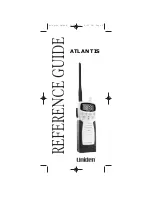
AE–1800 Instruction Manual l
Theory of Operation
8. Summar ized T heor y of Oper at ion
(
continued
–
2 /10 )
8 . 5 . N AV T E X Re c e i v e r – G e n e r al
A NAVTEX receiver that complies with the relevant IMO resolutions and regulations for
wheel mark certification is programmed to automatically receive and display/print a
message, and avoids a repeated reception of the same message by checking the ID and
numbering of each message. Using the ID and message type data attached to each
message, the user can also program the receiver to reject certain transmissions and
message types that are not of importance while in the current area, except for SAR and
other urgent warning messages classified as type D messages.
An audible and visual alarms are automatically triggered upon reception of such a
message. To silence the alarm, the user must manually, or via an appropriate command
from an INS terminal, acknowledge the message arrival. Received messages are either
printed on paper (for a receiver with a built–in printer) or displayed on a screen with
memory for storage and retrieval (for a receiver with an integral LCD screen).
8 . 6 . T h e
AE – 1 8 0 0
N AV T E X
R e c ei ve r
The
AE–1800
receiver has two built–in receivers on the same receiver board, with the
first receiver devoted to receiving 518 kHz broadcast at all times and the second
receiver receiving either 490 kHz or 4209.5 kHz signal as selected by the user through
the menu system. Received messages are displayed across an 8–inch liquid crystal
display (LCD) and stored permanently or temporarily as specified by the user.
Up to 200 messages, each with an average of 500 characters, received on the first and
second receivers are separately stored and then automatically erased from memory 60
hours after the time of reception on a first–in–first–out basis. However, up to 25
messages can be protected against automatic erasure, and are stored in a separate area
of the non–volatile message memory, in which case an additional 50 new messages can
be stored in memory for each receiver.
When a transmission occurs on the first and second receiver frequencies at the same
time, the equipment receives both signals, displaying the first receiver message while
storing the second receiver message in memory for later retrieval. An appropriate
caution message shows up in the screen bottom prompt line to indicate the reception of
a new NAVTEX message on the second receiver.
Reception of a type–D message (SAR, piracy and armed robbery information) activates
the audible and visual alarms. The received message text then is shown in red, making
it easy to discriminate it from navigational (type–A) and weather (type–B) warnings.
The audible alarm also sounds differently to indicate that a type–D message has been
received. The alarm can be acknowledged remotely by an IBS/INS terminal connected
to the RS–422 port on the rear panel. When a type–D message is received on the second
receiver alone, the display automatically switches to the second receiver page, showing
its message in red while sounding the alarm in the same manner as on the first receiver.
The stored messages can be output via three interface ports mounted on the rear panel
for IBS/INS or other onboard applications The user can specify the ID, frequency and
type of the messages you wish to output. An optional printer can also be plugged in to
print the current message in real time or those recalled from the non–volatile memory.
*
1
:
Global Maritime Distress and Safety System,
*
2
:
International Maritime Organization
*
3
:
International Telecommunications Union,
*
4
:
Safety of Life at Sea
(
continued on next page
)
















































